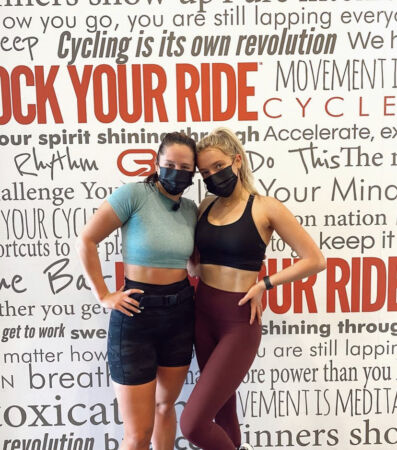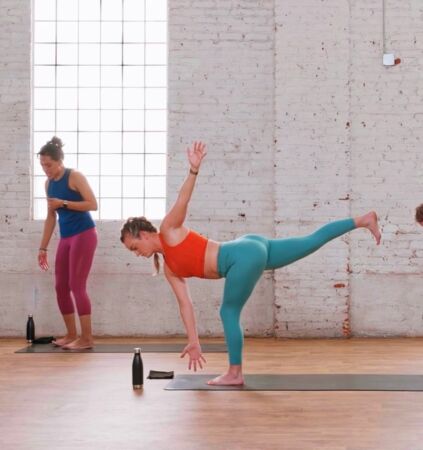Fitness in the time of COVID-19: Maintaining health in virtual vs. in-person spaces
By Claire Purnell
On March 14, 2020, I stepped into the heated, dimly lit moon-room studio at CorePower Yoga in South Boulder. Due to COVID-19, I had to catch a flight home the next morning to escape the unknown and potential danger that was to come in the following weeks, but I wanted to get one last Yoga Sculpt class in at CorePower before I had to leave for who knew how long. My heart had been pounding in my chest for several days straight, and I hoped this next hour in this room would provide some sort of escape from the mess of the world. The instructor tried to make her voice as soothing as she could, saying she was not sure what was going to happen, but we will adapt. This was my last workout at a studio for nearly three months.
I have been a group-fitness junkie since 2016, and I have tried countless studios including Orange Theory, F45, CycleBar, Soul Cycle, Pure Barre, Barre3, CorePower, Shred415 and many others. I perform my best in a group setting where things are constantly changing, music is blaring and I am surrounded by motivated people who all are there to put in work. In 2019, I started teaching spin classes at the University of Colorado Boulder’s Recreation Center; I am now a certified group fitness instructor. I am extremely passionate about group fitness, but the pandemic has caused me to wonder if group fitness will ever be the same as it was before March 2020.

When the majority of the country went into lockdown, fitness enthusiasts—whether they were studio owners, gym members or fitness instructors—all asked the same major question: How will we workout? Obviously, this question came after other worries, but it was still a main concern since fitness is such a crucial aspect of our lives. Studios shut down and were not sure how long they would be out of business or how to keep their lights on. Group fitness instructors lost their jobs and had no idea when they could return since group gatherings had become the enemy.
People who typically worked out in studios felt lost. As a group fitness instructor and participant, I was really worried. Like many, I was unsure when I would be back to work and, additionally, I was very concerned about how I would keep up my fitness routine to stay mentally and physically healthy.
During the first few weeks of lockdown, I worked out in my basement either following videos on YouTube or live streams on social media from studios I loved. None of it was ever what I wished it would be. Working out in my dark basement could never come close to the motivation and positive energy I found in group fitness classes. I tried to go for runs, but it was cold out and I am prone to shin splints. A few weeks in, I ordered myself a cheap spin bike from Amazon, but riding it was nothing like my classes at CycleBar. With this bike, I offered a few recorded spin classes on my social media as well as the CU Boulder Recreation Center’s YouTube channel for students who happened to have bikes at home. I spent all of lockdown waiting for gyms and studios to open back up. Many studio owners and members I knew were anxiously waiting as well.
However, other fitness instructors, studios and enthusiasts found ways to thrive during this time. This brings me to the heart of this story, my burning question: Did the pandemic change the way people workout?
CorePower Yoga is one of the most popular fitness studios on University Hill in Boulder. Nearly every day, CU Boulder students walk in with neatly tied up ponytails and tightly rolled up mats; and then, they walk out with red faces, dripping in sweat, from the heated rooms and high energy classes. The classes at CorePower are special because many of them incorporate weights, blocks and the heated room that stays between 93 and 95 degrees Fahrenheit.
Camille Burner, owner of the CorePower Yoga studio located on the Hill and South Boulder, remembers the day CorePower shut down due to the pandemic. Burner says, “Bri [the studio owner at the time] said we’d be closed for two weeks, but I had an intuition it would be at least a month”. The company had to act fast if they wanted to keep their members, but most members would not have access to a heated room with weights and blocks at home—so how would the atmosphere be recreated or could it be?

As studios shut down, they had to quickly adapt to the new way of the world: virtual everything.
“It took […] CorePower, as a whole, a while to get behind livestream,” says Burner. She explains that there were several layoffs, as well as instructors who were not willing or able to teach yoga from home—including herself.
“I refuse to do online yoga. I don’t have a good home environment for it,” says Burner. However, the company had to shift and they did, eventually offering CorePower Yoga on demand and live virtual classes.
“It’s taken pretty well and CorePower has put in a ton of work, making it as well received as our in-studio experience,” Burner reflects. “Now that there’s option for both, it’s taking off. It’s definitely lucrative.”
Shred415, another studio in Boulder, faced the same issues as Corepower did. Jennifer Saddoris, the owner of the Shred415 studio in Boulder, faced a tough decision in March like many businesses.
“Monday, March 16, we had to shut down. We knew it was coming and we were devastated,” says Saddoris. “In February and March, we were adding a new member every day, and then we had to shut down.”
Shred415 is a workout that incorporates four 15-minute intervals, with two on the treadmills or two on the floor with a deck, weights, mats and booty bands. Shred415 is not a workout to easily replicate at home, so the company had to get creative when it started offering livestream workouts on April 1.
Saddoris laughs, “We loved the wine bottles! I would tell the shredders, ‘Go get those two bottles of chardonnay you never use and let’s use them now!” and clients that did not own weights would use wine bottles, cans or any random household items in place of them.”
Saddoris got creative with the cardio aspect too, finding park benches to teach from or encouraging shredders to go out and walk or run for the 30-minute cardio portion. She told me the learning curve was steep and fairly overwhelming, but they figured out ways to keep some of their members moving until they could reopen the doors.
During lockdown, many other studios across the country had to get creative. I participated in Instagram live workouts from my favorite studios who offered them for free. But as the pandemic continued, companies had to start sharing virtual workouts in a more lucrative fashion.
At CorePower, new memberships were offered during lockdown that are still available today for those who are not ready to come back into the studio. CorePower now offers an “All Access” membership where yogis can workout in-studio, access Yoga On Demand (pre-recorded workouts) and CorePower live (live Zoom workouts).
Burner says, “CorePower has put in a ton of work making it as well received as our in studio experience. Now that there’s an option for both, it’s taking off. It’s definitely lucrative.” Shred415 in Boulder, on the contrary, has struggled a bit more supplying shredders with similar experiences to the ones in the studio and has lost 60 to 70% of their members.
When studios opened back up in Boulder during the summer of 2020, most continued to offer virtual and in-person classes, often using creative and different formats. Shred415 added a new style of class called Shred Replay. Shred Replay is an empty studio where one shredder and their roommates or family members can attend and workout without a mask. An instructor is not physically in the room during these classes. Instead, the customers watch one of the livestreams on a large TV in the studio. Saddoris says the Shred Replay sessions are what most people prefer: “They like to be in the studio by themselves with no masks” she explains. “Our shredders like to come in but the large groups with masks are still not preferred [for many people]”.
CorePower’s new class options are structured with some new requirements. Masks are mandatory during the entire class and mats are spaced out to allow for physical distancing. Both studio owners say their memberships are not close to what they were pre-pandemic. They feel the decline is due both because of the mask requirement and because people are still cautious about the virus.
Burner thinks that people have learned to like their “Plan B options for working out” and may not ever renew their memberships with the studio, explaining, “2020 was going to be the year that we were going to reach this super big company goal which was 100,000 CorePower yoga members by the end of 2020, and we were at 90,000. Now [in March 2021] we are kind of almost starting from scratch.”

Personally, I was thrilled the day I got to start my membership again and return to practicing yoga in the CorePower studio. As soon as I returned back to Boulder for my sophomore year in August of 2020, I attended both studios rather quickly.
The first time I stepped foot into Shred415 after the pandemic, I was shocked at how small the class sizes were. There were about three of us in a studio made for 31 participants. We wore our masks the entire time and picked the pieces of equipment that were farthest from each other. I was glad to be back in the studio, but it definitely did not feel the same.
Now, in March 2021, there are definitely more shredders. The capacity is still limited, but Saddoris suspects more people will not come back until masks are no longer mandatory during class. I don’t blame them. It is hard to find your maximum sprint on a treadmill while inhaling fabric into your mouth and gasping for air that is unavailable. However, Saddoris expects Shred415 to be back to where it was whenever the world becomes more normal.
“We haven’t had any members quit because they don’t like the workout […] Once the majority of the world is vaccinated, the home equipment will pick up dust and people will be so happy to workout with other people again,” says Saddoris.
Many of the fitness professionals I followed on Instagram turned the demand for livestreamed workouts into a new way to engage their followers and a full-time job even post pandemic. Kelsi Taylor provides some of my favorite online workouts. I was able to ask Kelsi Taylor how the pandemic affected her fitness brand. Taylor explains, “Before the pandemic, I had just started working at three fitness studios.”
She had received her reformer certification a few months prior and finally was getting into the rhythm of teaching at three different studios. At this time, she only taught in-person fitness.
“When the pandemic started, the studios completely closed and I lost all income. I decided in order to keep the momentum that was building, I needed to find a way to keep teaching and building my brand,” says Taylor.
As a result, Taylor began offering mat pilates classes, which she had never even taught before.
“I transitioned to teaching mat pilates on Instagram Live for tips and exposure. This led to me collaborating with fitness brands, reaching fitness fanatics that I never would have found otherwise, doing virtual private sessions with people all across the country and led to my social media manager,” explains Taylor. “It basically changed everything for me.”
Taylor’s brand blew up during lockdown. Her workouts were some that my friends and I did at home regularly. Eventually, Taylor needed to monetize her products, so she created her Patreon page which she then switched into her fitness membership platform where she posts new workouts twice a week.
“I definitely had a lot more people sign up than expected and it’s still something that gets me excited to work on every week,” Taylor says.
While other fitness instructors turned away from online workouts as soon as studios opened back up, Taylor has grown to love this way of teaching.
“I think the pandemic definitely changed how people workout. I think that there is a good chunk of people who will forever have changed their mindset and would rather stay at home and be in their safe space [on their own time],” says Taylor. “However, I think there are a lot of people who are excited to leave their homes and be able to get back into their workouts at the gym.”
Taylor now teaches some outdoor classes, in addition to classes on Zoom and on her Patreon.
“Thankfully, I’m working for both audiences and growing with both,” she explains.
Over lockdown, I saw many fitness instructors who had workouts go viral and gained many clients who paid for memberships to access their videos, while other fitness instructors still dreaded online workouts. These instructors still had tons of eager clients ready to book their classes as soon as studios opened back up. The decision of whether or not to focus on virtual or in-person fitness classes comes down to the person working out and whether they workout for more of a community aspect or if they have grown to love the virtual workouts from home.
So, did the COVID-19 pandemic affect how people workout? It depends on the person. I talked to a couple fellow college students who have been into fitness for a while, asking their opinions.
Kaitlyn Seikunas told me she would “almost always prefer group fitness classes or any other type of group workout over working out alone.” Over the pandemic, she has stayed active by running and also purchased her own Peloton bike, which has become her go-to form of exercise.
Even though group fitness classes are still her favorite she says, “I have not gone back to any gyms since they reopened. I used to love CorePower Yoga, the rec center at CU and spin classes, but I refuse to pay the same price to have to workout with a mask on.”
Seinkunas adds, “I just continue to do workouts virtually or I workout outside or in my apartment.” As Saddoris inferred, Seinkunas will likely return back to fitness studios once masks are no longer mandatory.
I talked to another friend and CU Boulder student, Maddie Sheifer, who also was a big studio fitness lover. She said she started with CorePower Yoga, but “my two true loves are Pure Barre and SoulCycle.” During lockdown, Sheifer used her treadmill to do exercises through running apps like Nike and Verv. She also ran long distances in her neighborhood.
“As more and more influencers began using Instagram and Zoom as a place to host workouts, I oftentimes joined in on Instagram Lives with one of my SoulCycle instructors as well as CorePower instructors whose workouts I found on Instagram,” Sheifer explains.
Since studios have now reopened, Sheifer has loved going to SoulOutside, which is SoulCycle outdoors and socially distanced with no masks. She says she has also been back to PureBarre. Sheifer says she is comfortable with any form of indoor exercise at studios when she lives away from her parents as she is worried about getting them sick.
As for me, I am back in fitness studios with a mask over the bridge of my nose and under my chin, trying to catch my breath and protect my face from mask-prone-acne. However, I would never trade studio workouts with masks for maskless home workouts. I will always love workouts for the community aspect, as it provides motivation through the instructor and peers as well as a reason to get out of my house and surround myself with some more positive experiences.
Do I think the pandemic changed the fitness industry? Definitely. I think some studios and instructors learned how to make their business more lucrative from livestream and virtual subscriptions. I think the other side will always have preference for the in-person community and less emphasis on virtual technology. It is definitely a personal preference, but I think the pandemic opened people’s eyes to more ways we can be active. If the pandemic has shown people new and more accessible ways they like to move, then maybe this is a small silver lining we can find from a really tough year.

